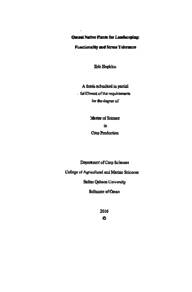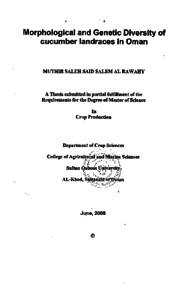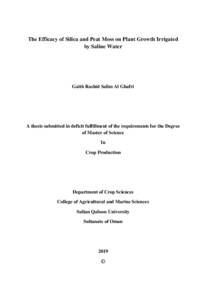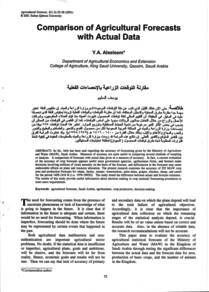Document
Omani native plants for landscaping: functionality and stress tolerance
Publisher
Sultan Qaboos University
Gregorian
2016
Language
English
Subject
English abstract
In Oman, the vast majority of the plant species found in developed landscapes are exotic species from other parts of the world. These species showcase abundant floral displays and verdant green foliage; they also tend to consume a large quantity of the limited precious natural resources in Oman, in particular, water. This study of Omani native plants, which consisted of four sections, aims to partially address the issue of the underuse of native Omani plants. The first section compiled a list of possible specimens for the developed landscapes of Oman from existing literature on Omani native plants. These consisted of 171 plants of 49 families divided into six groups: trees, large shrubs, small shrubs, perennials-annuals, climbers, and succulents. The second section tested the tolerance of three Omani native plant species, Dodonaea viscosa, Ipomoea pes-caprae, and Ziziphus spina-christi, to the abiotic stress combination of heat and drought. Plants were subjected to four different drought treatments in two locations for the heat treatments. No plants died from the treatments, but no plants showed complete tolerance to the combined treatments. Dodonaea viscosa was found to adapt to the drought treatments, but only in the cooler temperatures averaging around 30 °C. Ziziphus spina-christi performed well in the heat, but only when there was sufficient irrigation. Ipomoea pes-caprae produced the most new growth and its highest Carbon dioxide assimilation levels in the greenhouse locations. three plants showed adaptability to both locations and all treatments. The third section further tested the tolerance of Dodonaea viscosa, Ipomoea pes-caprae, and Ziziphus spina-christi, to the abiotic stress combination of heat and salinity. Plants were subjected to four different salinity treatments in two locations for the heat treatments. The combination of the heat in the field location and the higher two salinity levels proved fatal for Dodonaea viscosa; however, the plant adapted to the salinity treatments in the cooler temperatures of the greenhouse location. Ziziphus spina-christi had the highest levels of photosynthesis in the greenhouse, but larger growth on plants in the field. Ipomoea pes-caprae had its greatest Carbon dioxide assimilation rates and the most new and densest growth in the greenhouse. All three species showed adaptability to the high temperatures in the field, but with varying degree of
resilience to the combination with high salinity levels. These two separate experiments demonstrated that the three species tested could survive in many of the demanding environments that Oman's developed landscapes provide. The fourth section of the study monitored seven native Omani plant species, Anogeissus dhofarica, Adansonia digitata, Delonix elata, Ipomoea pes caprae, Prosopsis cineraria, Tamarindus indica, and Ziziphus spina-christi, for the effects they have on their microclimates in the wild as well as in developed landscapes. Most species had denser growth in the developed landscape and changed the microclimates of their canopies by reducing temperatures, increasing relative humidity, reducing light, and reducing wind speed. These effects also carried through to below canopy zones due to their shading through insolation abatement. Overall, this experiment showed that these Omani native plant species have the ability to impact their surrounding microclimates in a positive way. The study further showed that while some species had more of an impact in their natural settings, others had more of an impact in the developed landscape. In either case, all the species studied proved they could be functional additions to the developed landscapes of Oman
Member of
Resource URL
Arabic abstract
استخدام النباتات العمانية المحلية في زراعة المناظر الطبيعية: الصفات الوظيفية وتحمل الاجهاد
الغالبية العظمى من النباتات الزينة في سلطنة عمان المزروعة كمناظر طبيعية هي نباتات غير محليه ومستوردة من بلدان أخرى من العالم. معظم هذه النباتات تحتوي على ازهار وأوراق شجر خضراء كثيفة تستهلك كمية كبيرة من الموارد الطبيعية الثمينة المحدودة في السلطنة كالماء على وجه الخصوص. ولذلك تهدف هذه الدراسة ، والذي تتألف من أربعة تجارب، إلى معالجة مسألة علم استعمال النباتات العمانية البرية المحلية في تطوير المناظر الطبيعية. ويعرض الجزء الأقل من الأبحاث قائمة النباتات الممكن استخدامها كمناظر طبيعية اعتمادا على مراجع النباتات العمانية المتوغرة، وخلصت الدراسة إلى أنه يوجد 171 من نباتات من 49 عائلة نباتيه مقسمة إلى ست مجموعات: أشجار والشجيرات الكبيرة والشجيرات الصغيرة، النباتات المعمرة، الحولية، والمتسلقه، والجافة. أما التجرية الثانية والتي أجريت عليها معاملات الجفاف والحرارة فتتالف من ثلاثة نباتات محلية وهم: Dodonaea viscosa , Ipomoea pes - caprae , Ziziphus spina
- christi . وقد تم اختيار أربعة معاملات مختلفة للجفاف تم تطبيقها على النباتات في موقعين مختلفين وهما الحقل والبيوت الخضراء مع درجات حرارة مختلفتين. لم تمت النباتات من جراء معاملات الجفاف والحرارة وايضا لم تقاوم معاملات الجفاف والحرارة بصورة تامة. أظهرت النتائج أن نباتات الشحس Dodonaea viscosa تتاقلم مع معاملات الجفاف عند متوسط درجات الحرارة 30 درجة مئوية. أما السدر الشوكي Ziziphus spina - christi تتاقلم ايضا مع معاملات الجفاف ولكن فقط عندما يكون هناك ري مناسب وكافي. أما Ipomoea pes
- caprae فقد أنتجت نموات جديدة وايضا أعلى مستويات التمثيل الضوئي في الحقل والبيوت الخضراء. لذا أظهرت جميع النباتات المحلية الثلاثه القدرة على التكيف مع كلا من معاملات الجفاف و مواقع الحرارة. أما التجربة الثالثة وتتالف ايضا من ذات النباتات الثلاث في الدراسة السابقة حيث تم تطبيق معاملات الملوحة والحرارة عليها وقد تم اختيار اربعة معاملات ملوحة تم تطبيقها على النباتات في موقعين وهما الحقل والبيوت الخضراء مع درجات حرارة مختلفتين. لم تتحمل نبات الشحس Dodonaea viscosa معاملات الملوحة والحرارة العالية تحت ظروف الحقل ولكن أظهرت مقاومة ملموسة لمعاملات الملوحة والحرارة المنخفضة في البيت الخضراء. أما السدر الشوكي Ziziphus spina - christi انتجت أعلى مستويات التمثيل الضوئي في البيت الخضراء بينما انتجت معظم النموات الجديدة في الحقل. أما Ipomoea pes - caprae فقد انتجت أعلى مستويات التمثيل الضوئي و معظم النموات الجديدة والكثيفة في البيت الخضراء. اظهرت جميع الأنواع النباتية الثلاثة مقاومتها للحرارة في الحقل مع مقاومة جيدة ومتباينة للملوحة. تظهر هذه التجربتين للمجموعتين الثانية والثالثة أن هذه انواع النباتات الثلاثة تستطيع البقاء على قيد الحياة و تحمل الظروف البيئية المختلفة و المكونة للطبيعة الخضراء في عمان. أما التجربة الرابعة من هذا البحث تتالف من سبعة نباتات محلية: Anogeissus elata, Ipomoea pes-caprae, dhofarica, Adansonia digitata, Delonix Prosopsis cineraria , Tamarindus indica , and Ziziphus spina - christi والتي تهدف الى رصد تأثير هذه النباتات على عناصر المناخ المختلفة سواء في الطبيعة البرية او الاراضي الخضراء المطورة. اثبتت النتائج جودة تلك النباتات المحلية في تخفيض وتلطيف درجات الحرارة وايضا الحد من ضوء وسرعة الرياح وزيادة الرطوبة النسبية، وذلك بسبب الظل الكبير الناتج من الأوراق الخضراء الكثيفة لتلك النباتات والتي تسبب العزل الحراري والضوئي وبالتالي تلطيف المناخ. وعموما، أظهرت هذه التجربة أن هذه الأنواع النباتية المحلية العمانية لديها القدرة على التأثير المناخات المحيطة بها بطريقة إيجابية. وكشفت الدراسة أيضا أنه في حين أن بعض من هذه النباتات لها تأثير أكثر في المناطق البرية وبعضها في الأراضي الخضراء المطورة. في كلتا الحالتين، أثبتت الدراسات أن كل تلك الأنواع يمكن أن تساهم في القيمة الوظيفية والمناظر الطبيعية المطورة في سلطنة عمان.
الغالبية العظمى من النباتات الزينة في سلطنة عمان المزروعة كمناظر طبيعية هي نباتات غير محليه ومستوردة من بلدان أخرى من العالم. معظم هذه النباتات تحتوي على ازهار وأوراق شجر خضراء كثيفة تستهلك كمية كبيرة من الموارد الطبيعية الثمينة المحدودة في السلطنة كالماء على وجه الخصوص. ولذلك تهدف هذه الدراسة ، والذي تتألف من أربعة تجارب، إلى معالجة مسألة علم استعمال النباتات العمانية البرية المحلية في تطوير المناظر الطبيعية. ويعرض الجزء الأقل من الأبحاث قائمة النباتات الممكن استخدامها كمناظر طبيعية اعتمادا على مراجع النباتات العمانية المتوغرة، وخلصت الدراسة إلى أنه يوجد 171 من نباتات من 49 عائلة نباتيه مقسمة إلى ست مجموعات: أشجار والشجيرات الكبيرة والشجيرات الصغيرة، النباتات المعمرة، الحولية، والمتسلقه، والجافة. أما التجرية الثانية والتي أجريت عليها معاملات الجفاف والحرارة فتتالف من ثلاثة نباتات محلية وهم: Dodonaea viscosa , Ipomoea pes - caprae , Ziziphus spina
- christi . وقد تم اختيار أربعة معاملات مختلفة للجفاف تم تطبيقها على النباتات في موقعين مختلفين وهما الحقل والبيوت الخضراء مع درجات حرارة مختلفتين. لم تمت النباتات من جراء معاملات الجفاف والحرارة وايضا لم تقاوم معاملات الجفاف والحرارة بصورة تامة. أظهرت النتائج أن نباتات الشحس Dodonaea viscosa تتاقلم مع معاملات الجفاف عند متوسط درجات الحرارة 30 درجة مئوية. أما السدر الشوكي Ziziphus spina - christi تتاقلم ايضا مع معاملات الجفاف ولكن فقط عندما يكون هناك ري مناسب وكافي. أما Ipomoea pes
- caprae فقد أنتجت نموات جديدة وايضا أعلى مستويات التمثيل الضوئي في الحقل والبيوت الخضراء. لذا أظهرت جميع النباتات المحلية الثلاثه القدرة على التكيف مع كلا من معاملات الجفاف و مواقع الحرارة. أما التجربة الثالثة وتتالف ايضا من ذات النباتات الثلاث في الدراسة السابقة حيث تم تطبيق معاملات الملوحة والحرارة عليها وقد تم اختيار اربعة معاملات ملوحة تم تطبيقها على النباتات في موقعين وهما الحقل والبيوت الخضراء مع درجات حرارة مختلفتين. لم تتحمل نبات الشحس Dodonaea viscosa معاملات الملوحة والحرارة العالية تحت ظروف الحقل ولكن أظهرت مقاومة ملموسة لمعاملات الملوحة والحرارة المنخفضة في البيت الخضراء. أما السدر الشوكي Ziziphus spina - christi انتجت أعلى مستويات التمثيل الضوئي في البيت الخضراء بينما انتجت معظم النموات الجديدة في الحقل. أما Ipomoea pes - caprae فقد انتجت أعلى مستويات التمثيل الضوئي و معظم النموات الجديدة والكثيفة في البيت الخضراء. اظهرت جميع الأنواع النباتية الثلاثة مقاومتها للحرارة في الحقل مع مقاومة جيدة ومتباينة للملوحة. تظهر هذه التجربتين للمجموعتين الثانية والثالثة أن هذه انواع النباتات الثلاثة تستطيع البقاء على قيد الحياة و تحمل الظروف البيئية المختلفة و المكونة للطبيعة الخضراء في عمان. أما التجربة الرابعة من هذا البحث تتالف من سبعة نباتات محلية: Anogeissus elata, Ipomoea pes-caprae, dhofarica, Adansonia digitata, Delonix Prosopsis cineraria , Tamarindus indica , and Ziziphus spina - christi والتي تهدف الى رصد تأثير هذه النباتات على عناصر المناخ المختلفة سواء في الطبيعة البرية او الاراضي الخضراء المطورة. اثبتت النتائج جودة تلك النباتات المحلية في تخفيض وتلطيف درجات الحرارة وايضا الحد من ضوء وسرعة الرياح وزيادة الرطوبة النسبية، وذلك بسبب الظل الكبير الناتج من الأوراق الخضراء الكثيفة لتلك النباتات والتي تسبب العزل الحراري والضوئي وبالتالي تلطيف المناخ. وعموما، أظهرت هذه التجربة أن هذه الأنواع النباتية المحلية العمانية لديها القدرة على التأثير المناخات المحيطة بها بطريقة إيجابية. وكشفت الدراسة أيضا أنه في حين أن بعض من هذه النباتات لها تأثير أكثر في المناطق البرية وبعضها في الأراضي الخضراء المطورة. في كلتا الحالتين، أثبتت الدراسات أن كل تلك الأنواع يمكن أن تساهم في القيمة الوظيفية والمناظر الطبيعية المطورة في سلطنة عمان.
Category
Theses and Dissertations




